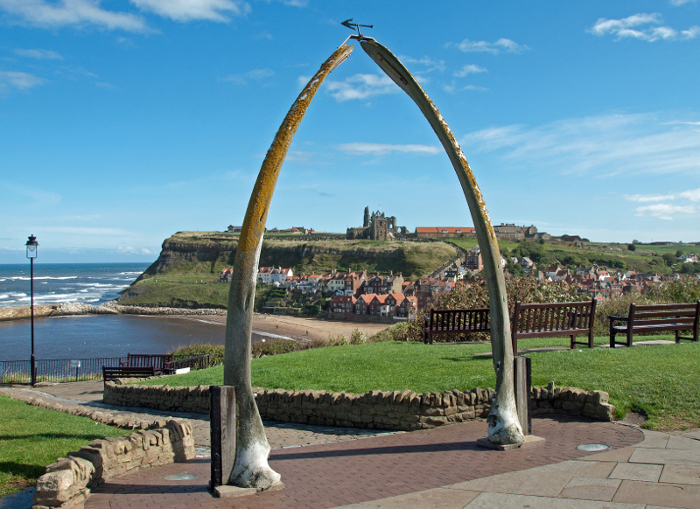The Whitby Whale Bone Arch, situated on the town’s West Cliff, stands as a poignant tribute to Whitby’s rich maritime heritage, particularly its historical ties to the whaling industry. This iconic structure not only offers a striking visual landmark but also serves as a window into the town’s past, reflecting the economic and cultural significance of whaling in the 18th and 19th centuries.
Historical Background
Whitby’s involvement in the whaling industry began in the mid-1700s. By the late 18th century, the town had become a prominent whaling port, with numerous ships venturing into Arctic waters in pursuit of whales. The industry brought considerable wealth to Whitby, fueling the construction of grand homes and contributing to the town’s development. However, whaling was a perilous endeavor; many ships were lost to treacherous ice and storms, and the toll on whale populations was significant.
The Evolution of the Arch
The original Whale Bone Arch was erected in 1853, constructed from the jawbones of a whale, symbolizing the town’s connection to the whaling industry. Over time, the arch became a cherished landmark. Due to weathering, the original bones were replaced in 1963 with a set donated by Norwegian whalers, taken from a 113-ton Fin whale. These, too, succumbed to the elements, leading to another replacement in 2003. The current arch comprises bones from a Bowhead whale, legally obtained through a subsistence hunt by Alaskan Inuits. The previous sets are preserved in the Whitby Archives & Heritage Centre.
Cultural Significance
Beyond its physical presence, the Whale Bone Arch serves as a cultural touchstone for Whitby. It encapsulates the town’s historical reliance on the sea and the industries it supported. The arch also prompts reflection on the environmental and ethical considerations of whaling, highlighting the balance between economic pursuits and conservation—a dialogue that continues in contemporary discussions about sustainable practices.
Visiting the Arch
Located on North Terrace, the Whale Bone Arch offers panoramic views of Whitby, including the harbor and the ruins of Whitby Abbey. Adjacent to the arch stands a statue of Captain James Cook, further cementing the area’s maritime legacy. Visitors can access the site via a climb up the West Cliff, rewarded with both historical insight and scenic vistas.
In summary, the Whitby Whale Bone Arch is more than a mere monument; it is a narrative in bone and stone, telling the story of a town shaped by the sea, its fortunes, and its follies. As both a historical artifact and a symbol of reflection, the arch invites contemplation of humanity’s relationship with nature and the enduring impact of our industries on the world around us.

